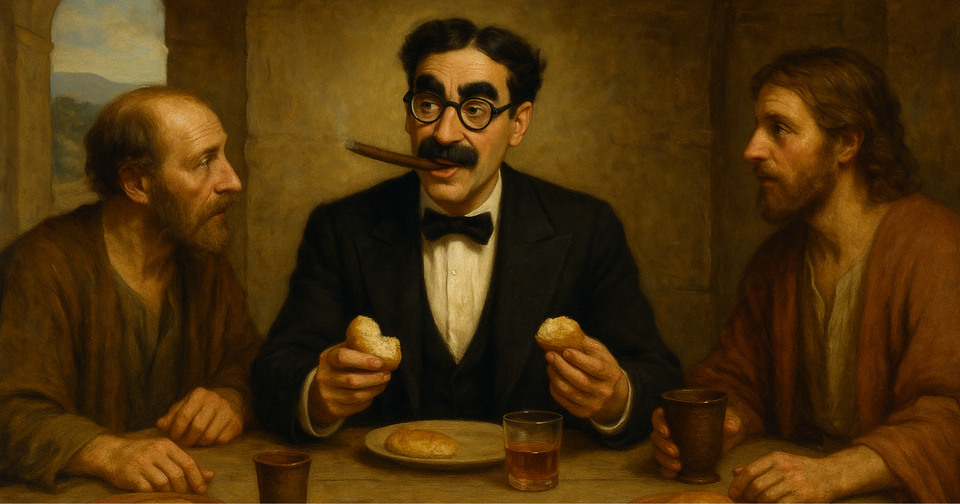Why Didn't the Disciples Recognize Jesus After the Resurrection?

Table of contents
The Great Disappointment: A Crash Course in Letdown Theology
Imagine giving away your farm, quitting your job, and putting on your best white robe to watch the sky for Jesus—only for October 22, 1844, to roll by like any other Wednesday. Welcome to the world of the Millerites, a 19th-century apocalyptic movement led by William Miller. Convinced that Jesus would return on that date, thousands of followers waited expectantly. Spoiler alert: he didn’t show.
But here’s the twist—many didn’t abandon the belief. Instead, they got creative. Some said Jesus had returned, just not in a way anyone could see. Others claimed the date marked a heavenly event invisible to human eyes. Thus, instead of collapsing, the movement pivoted. From its ashes rose new religious groups like the Seventh-day Adventists, who reinterpreted the disappointment as part of a divine plan cleverly hidden from view (Festinger et al. 1956).
Déjà Vu in Devotion: Other Faiths That Rewrote the Ending
This kind of theological improvisation isn’t unique. It’s a classic case of cognitive dissonance: when expectations crash headfirst into reality, we don’t always ditch the belief—we renovate it.
Take Sabbatai Zevi, a 17th-century Jewish messianic figure. When he was forced to convert to Islam, you’d think that would be the end of that. But no—his followers decided it was all part of the plan. A mystical one. Naturally.
Or look at the Rastafarian reverence for Haile Selassie. When he died in 1975, many followers refused to accept it. He hadn’t died, they said—he’d transcended into the spiritual realm. Death, it seemed, was just another costume change.
And then there are the Cargo Cults of Melanesia, born from encounters with Westerners during World War II. These visitors brought with them unimaginable material goods—radios, canned food, airplanes. When the goods stopped arriving, indigenous communities didn’t give up. They crafted elaborate rituals to bring the cargo back, interpreting the whole encounter through their own sacred lens.
In all these cases, belief didn’t break under the weight of unmet expectations. It bent, twisted, and reshaped itself into something that could still make sense of the world. When reality disagrees with belief, reality must be mistaken.
Now Enter Jesus, Stage Left
Let’s take that same psychological toolkit and apply it to the resurrection story. The execution of Jesus wasn’t just unexpected—it was a gut punch to his followers’ worldview. Whatever else Jesus thought of himself, the idea that he believed he was going to be crucified and rise again three days later feels suspiciously like a story written after the fact. Scholars like Bart Ehrman argue Jesus likely saw himself as a prophet—maybe even the precursor to a messianic figure, but not the endgame himself (Ehrman 2014).
So when Jesus was arrested, humiliated, and killed, the disciples were left holding the theological equivalent of a shredded treasure map. And that’s exactly the kind of moment where cognitive dissonance sneaks in and starts redecorating. For a wider critique of Easter claims, see resurrection debunked.
“Wait… That Was Jesus?”: The Pattern of Sudden Realization
Take a look at how the resurrection stories play out. They’re strangely consistent in one respect: nobody seems to recognize Jesus at first.
In Luke 24, two disciples are walking to Emmaus, discussing everything that just went down. A stranger joins them. They pour out their grief to him—clearly not recognizing who he is—until, over dinner, it suddenly clicks: this was Jesus the whole time! And then, poof—he vanishes. “Then their eyes were opened, and they recognized him; and he vanished from their sight.” (Luke 24:31, NRSVUE). It reads less like a physical reappearance and more like a psychological breakthrough.

John’s Gospel gives us another version: Mary Magdalene sees a man near the tomb and mistakes him for the gardener. Only when he says her name does she recognize him (John 20:14–16). That moment—recognition triggered by emotion, not sight—fits the pattern. For another look at miracle claims strained through reality, see the Weeping Jesus of Mumbai.
And in John 21, the disciples are fishing when a man on the shore gives them fishing advice. Only after their nets fill do they suddenly realize it’s Jesus. Was it him all along, or did the recognition come because something clicked in their grief-fogged minds?
These scenes play like parables of emotional catharsis. The recognition doesn’t come from seeing Jesus—it comes from a desperate need to believe there was more to his death than defeat. For a parallel in pagan miracle-talk, compare Asclepios and Jesus: the resurrection that wasn’t.
Thomas the Skeptic: A Useful Character
Then there’s Thomas. Doubting Thomas. The guy who says, “Unless I see the mark of the nails… I will not believe.” (John 20:25, NRSVUE). His story reads like a plug-in module to explain why some people in the early Jesus movement were skeptical. He’s the stand-in for everyone who said, “Come on, that’s a bit much.” But then—cue the dramatic climax—he touches Jesus and declares, “My Lord and my God!” A tidy resolution for doubters that doubles as a sales pitch: even the hardest case came around.
Scholars suggest this may be retrofitted storytelling—a way to validate the emerging belief in resurrection by showing it overcame even rational resistance.
Conclusion: Faith, Fracture, and the Power of Story
So what if the resurrection wasn’t a single miraculous event, but the product of emotional trauma, shattered expectations, and collective reinterpretation? In the wreckage of Jesus’ death, his followers needed meaning. They needed closure. And when the body couldn’t be found—or perhaps more accurately, when the absence of Jesus created narrative room—belief filled the vacuum.
In that light, the resurrection begins to look less like divine proof and more like what happens when deeply invested people experience loss and confusion. It’s not deception—it’s reorientation. And like the Millerites, the cargo cultists, and the disciples of Zevi, early Christians responded to disillusionment not by giving up, but by rewriting the story to keep hope alive.
Over time, those stories crystallized—first into rumors, then into testimonies, then into scripture.
FAQ
Why do the Gospels show people failing to recognize Jesus?
Because non-recognition fits a literary and psychological pattern. Scenes like Emmaus (Luke 24) and the garden (John 20:14–16) resolve with sudden recognition tied to emotion or ritual, not eyesight. That pattern aligns with how communities reinterpret loss to keep core beliefs intact.
Isn’t this just calling believers deluded?
No. The point is about normal human cognition under stress. From the Millerites to Sabbatai Zevi’s followers, people often reinterpret failed expectations. That doesn’t require deceit—just the brain’s need for coherence.
What evidence supports the cognitive-dissonance angle?
Classic social-psych work like Festinger’s study of the 1950s prophecy group documents how strong commitments survive disconfirmation by reframing outcomes. The Gospel recognition stories map neatly onto that pattern of reinterpretation.
Do any early sources outside the Gospels give clear appearance details?
The earliest Christian writer, Paul, mentions appearances but doesn’t narrate recognition scenes. The detailed episodes come from later narrative Gospels, where the non-recognition motif is a recurring device.
Works Cited
- Ehrman, Bart D. How Jesus Became God: The Exaltation of a Jewish Preacher from Galilee. HarperOne, 2014.
- Festinger, Leon, Henry W. Riecken, and Stanley Schachter. When Prophecy Fails: A Social and Psychological Study of a Modern Group That Predicted the Destruction of the World. Harper & Row, 1956.
- The Holy Bible, New Revised Standard Version Updated Edition. National Council of Churches, 2022.
- Vermes, Geza. The Resurrection: History and Myth. Doubleday, 2008.


Comments ()